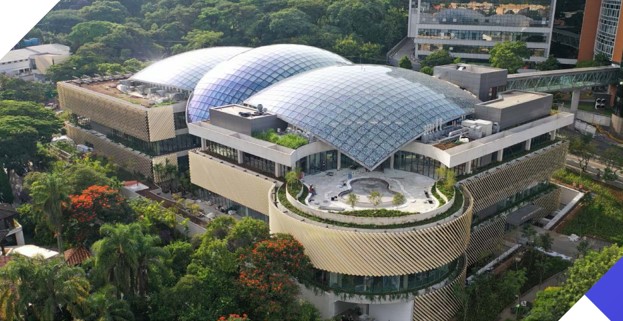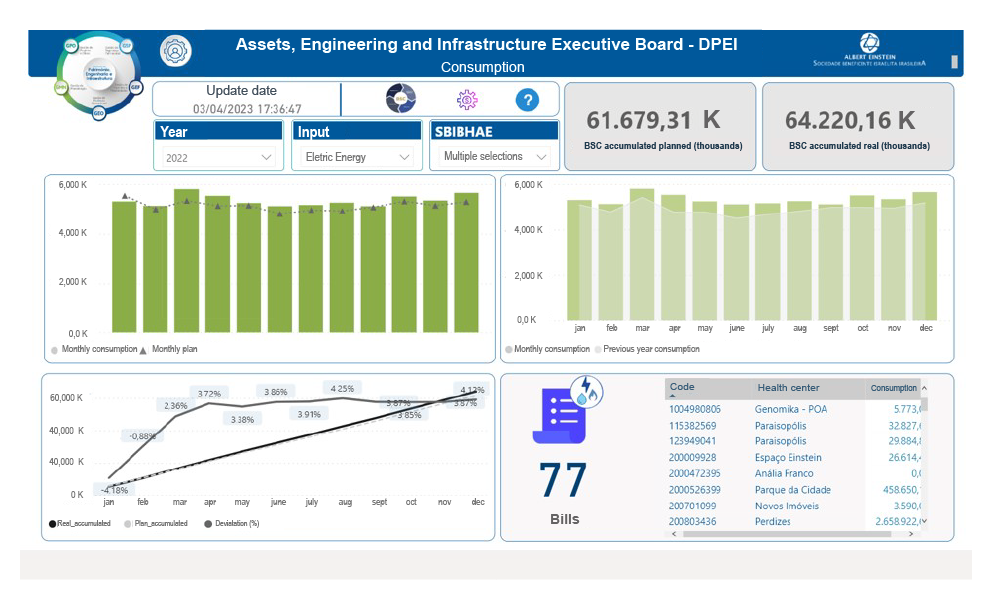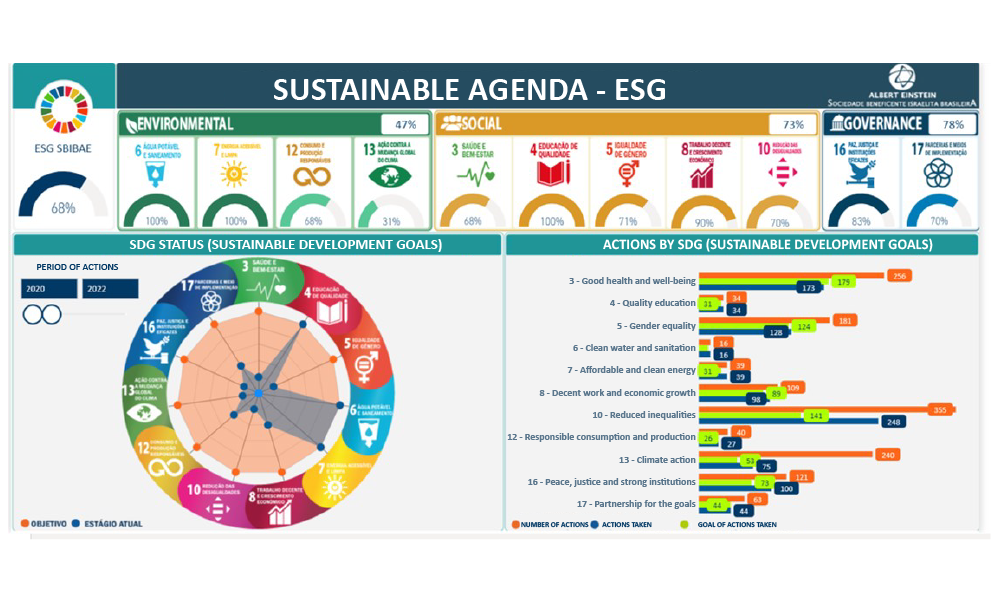More than 70% renewable energy & significant GHG reductions: Climate leadership & sustainability strategies
Sociedade Beneficente Israelita Brasileira Albert Einstein
Case study summary
This case study presents the journey of the Sociedade Beneficente Israelita Albert Einstein, a large and highly complex hospital, in relation to climate change, focusing on its actions to mitigate emissions through energy efficiency projects and initiatives to adapt to the effects of climate change.
Demographic information
- City: São Paulo
- State/province/region: SP
- Country: Brazil
- Type of institution: Philanthropic hospital
- Number of full-time staff: 19,897
- Number of part-time staff: 5,395
- Number of beds: 1,365
- Patient population served annually
- 5,648,747 patients served annually (inpatient and outpatient)
- Geographic area served: Metropolitan Region of São Paulo and Midwest region of Brazil
- Equity concerns experienced by your population: To enable everyone to achieve their full potential for health; to expand the reach of actions to larger segments of the population

The issue
Given the significance of climate change and its risks to the health care system, our institution has mobilized to reduce its carbon footprint. The health care sector accounts for 4.4% of global greenhouse gas emissions, necessitating innovation in products and processes for a low-carbon economy. This action not only prevents the most severe impacts of climate change but also promotes health. Our institution is committed to contributing to the reduction of greenhouse gas emissions, consistent with various commitments prioritizing human health.
Hospital goal
To mitigate the impact of our institution on carbon emissions and prepare for the effects of climate change, we've developed an adaptation plan. Additionally, we strive to influence the health care sector by emphasizing the importance of addressing climate change.
Sustainability strategy implemented
The Hospital Albert Einstein began the GHG inventory in 2007. At the time, carbon inventories in Brazil were nascent, making comparative analysis difficult. The inventory helped identify opportunities with the infrastructure department to prioritize the development of an efficiency program to reduce emissions related to electricity and diesel. In 2011, the hospital developed a sustainability master plan including guidelines for environmental action, all of which converged towards reducing GHG.

Brazil, as a country of continental dimensions and significant social disparities, is already experiencing the consequences of climate change such as hunger and malnutrition caused by a decline in food production, the proliferation of infectious diseases, increasing destruction caused by extreme weather events. At Einstein, we are leading discussions that show the effects of climate on health and looking at our operations with commitments to neutralize carbon emissions by 2050.
Implementation process
Over the past years, Einstein has implemented process improvements that contributed to emissions reduction. For instance, a project aimed at curbing nitrous oxide consumption has prevented the emission of 17,278.05 tCO₂e since 2013. To trim electricity use, an energy efficiency program was initiated, encompassing the replacement of mercury lamps with LEDs, the installation of a photovoltaic plant at the Morumbi unit, the modernization of electrical infrastructure, and the procurement of renewable energy certificates to offset electricity consumption emissions. The logistics sector adopted measures like prioritizing ethanol for fleet vehicles and employing bicycles for report and document deliveries. Embracing the Race to Zero commitment, Einstein devised a strategic action roadmap with its boards, targeting the most impactful activities to achieve the set goals. A climate vulnerability study was also conducted, providing input for the institution's strategic planning and serving as the foundation for the implementation of an adaptation plan. This aligns with the institution's goal of optimizing processes and reducing emissions.
Tracking progress
Since 2010, Einstein has been publicly disclosing its greenhouse gas inventories on the public emissions registry platform. The inventory undergoes external verification and serves as the foundation for assessing all implemented enhancements. Within its management process, GHG emissions are monitored monthly and specific targets are set by senior management. The outcomes are rigorously scrutinized by stakeholders, and any deviations are rectified through corrective actions. GHG emissions data is incorporated into an ESG dashboard, constituting one of the metrics in the organization's balanced scorecard.
Dashboard for energy consumption monitoring

Dashboard for monitoring natural gas consumption

Dashboard: Monitoring the maturity of the Sustainable Development Goals (SDGs)

Progress achieved
Through the N₂O consumption reduction project, Einstein managed to avoid the emission of approximately 17,278.05 tCO₂e, which is a significant achievement. However, the most significant result of this project was the influence it had on other organizations to adopt the same actions. The energy efficiency program also led to a considerable reduction in emissions, with 71% of the electricity purchased by Einstein now coming from renewable sources. Additionally, another important gain was the incorporation of climate change into the organization's strategy. This enabled the discussion of the topic at the highest hierarchical levels, as well as the dissemination of climate culture to all professionals involved.
Graph of nitrous oxide consumption per year

Challenges and lessons learned
The challenge for Hospital Albert Einstein was to lead the reduction of GHG emissions without having adequate methodologies for the sector. Millions of reais were invested mainly in energy efficiency, but the internal culture still needed to be developed. The involvement and commitment of top management were essential for the sustainability and carbon mitigation plan to advance. It is important to involve everyone in disseminating the culture and to ensure transparency in reporting data. The topic should be present in the organization's strategy to ensure a long-term commitment.
Next steps
The focus will be on the carbon-neutral study with actions and projects to ensure commitment to reduction, as well as the climate vulnerability study to identify and mitigate risks. Another point is to reduce nitrous oxide and engage employees through forums and participatory committees with the participation of top management.